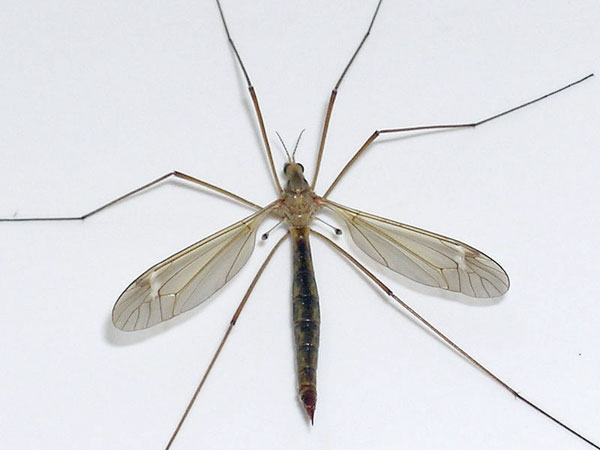
Live fast, crash headfirst into the porch light.
The crane flies are out and about this evening.
These creatures are a familiar sight everywhere during their brief mating season each year — flimsy tangles of thready legs and cellophane wings smacking into window screens and lampshades, dangling from spider webs, drowning in teacups, the survivors finally disintegrating after a few days into a litter of disorganized limbs under the porch light.
The insects we call crane flies are from the family Tipulidae: there are more than 4,200 species identified at present, and they live pretty much everywhere. (Here in Arkansas the most common crane flies belong to the genus Tipula.) The larvae, called “leatherjackets”, live in soil, eating organic debris and plant roots, maturing in early spring. The emerging adults, sometimes called “mosquito hawks”, may eat very small amounts of flower nectar, but many species lack digestive systems altogether and are unable to take in any kind of nourishment at all. Once they reach maturity, death is imminent: few adult crane flies will last a week.
To add insult to injury, birds, dragonflies, mantises, and other predators feed on the adult crane fly; the larvae is consumed by opossums, mice, moles, and predatory beetles.
The mayfly, a distant relative of the dragonflies, is virtually proverbial for its brief moment in the open air, as some species live as adults for literally only minutes before mating, laying eggs, and falling apart; adult mayflies don’t even have functional mouths, and their digestive systems are simply filled with air.
Crane flies are often associated with mosquitoes, to whom they are related, but they are not bloodsuckers; they can’t bite. The adult quite literally lives only to mate, lay eggs, and die. There just isn’t time for anything else.
Although I realize that they are completely harmless, I find crane flies rather disturbing. Their clumsiness, their absurd fragility, banging into walls and ceilings, shedding legs as they go, coupled with their frantic efforts to cope with the responsibility for the survival of their species in the few hours of life allotted to them, makes me want to flinch every time I see one. They just seem too weak, too poorly constructed, to bear the weight of even such a brief existence.
We humans, by comparison, live an average of four to five thousand of their lifetimes.
What if, somewhere out there in the universe, there was a being with a lifespan of 350,000 years? Would he look at us, flickering through our tiny little lives, and wonder why we bother? He wouldn’t see an Einstein or a Picasso or an Abraham Lincoln: he’d just see a frail little creature racing from birth to oblivion so quickly as to hardly have existed at all. On the other hand, as his own glacial Einstein might tell him, time is relative: how much you seem to have depends a lot on what you’re doing with it.
“Let us roll all our strength and all
— Andrew Marvell, from “To His Coy Mistress“
Our sweetness up into one ball,
And tear our pleasures with rough strife
Through the iron gates of life:
Thus, though we cannot make our sun
Stand still, yet we will make him run.”
* * *
